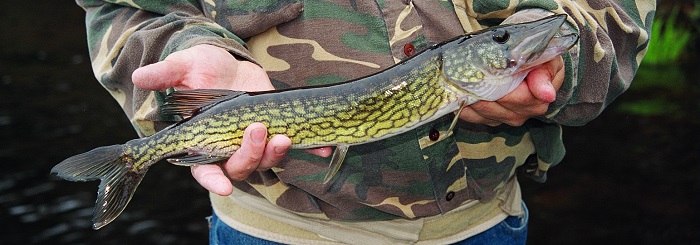Aquatic Invasive Species

The intentional or accidental introduction of fish or other aquatic organisms from one lake or stream to another can negatively affect local fish populations through competition, disease, or genetic changes. No one is allowed to release live fish into the waters of the province, except under a license issued by the Department of Fisheries and Oceans. Unwanted fish species can be accidentally spread by releasing unused live bait.
Because of the potential threat to local fish populations, it is also illegal to use certain species as bait or to possess them for bait (whether alive or dead). These include bass, bullhead, white perch, yellow perch, goldfish, pickerel, or any fish not taken from provincial waters.
Public notification
Measures are in place to prevent the spread of Chain Pickerel in the East River, Pictou County, watershed. Chain Pickerel is an aquatic invasive species and poses a significant threat to the trout and Atlantic salmon populations. Pursuant to Section 22 of the Aquatic Invasive Species Regulations a mandatory retention order is in place for Chain Pickerel until further notice.
If you catch a Chain Pickerel:
- Do not release it, or any parts of it.
- Quickly and ethically euthanize the fish.
- You may retain the fish for personal use; however, its sale is prohibited.
- Please report the location(s) you caught Chain Pickerel, including the GPS coordinates if possible and a photo of the fish by email to the Department of Fisheries and Aquaculture at inland@novascotia.ca or contact us at 1-902-485-5056
Report any sightings of invasive species, if possible with date, location and picture to: inland@novascotia.ca or XMARinvasive@mar.dfo-mpo.gc.ca
Report illegal fishing activities or information related to illegal introductions to your local office of Natural Resources and Renewables at 1-800-565-2224, or Department of Fisheries and Oceans at 1-800-565-1633, or Nova Scotia Crime Stoppers at 1-800-565-TIPS (8477).
For examples of aquatic invasive species, and Canada’s plan to address aquatic invasive species see Canadian Action Plan to Address the Threat of Aquatic Invasive Species on Fisheries and Oceans Canada website.
Clean – Drain – Dry
- Inspect your boat, motor, trailer, and boating equipment such as anchors and fishing gear, centerboards, rollers, and axles. Remove any animals and plants that are visible before leaving any waterbody.
- Drain water from the motor, live well, bilge and transom wells while on land immediately before leaving the waterbody.
- Wash out or dry your boots, waders, boat, tackle, trailer, and other boating equipment to kill harmful species that were not visible at the boat launch. Some aquatic species can survive more than two weeks out of water. Therefore, it is important to:
- Rinse your boat and equipment that normally gets wet with hot tap water (greater than 40°C), or
- Spray your boat and trailer with high pressure water (250 psi), or
- Dry your boat and equipment in the sun for at least 5 days before transporting them to another body of water.
